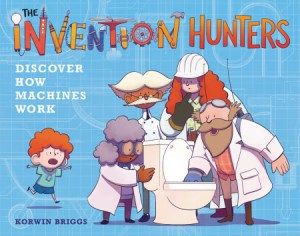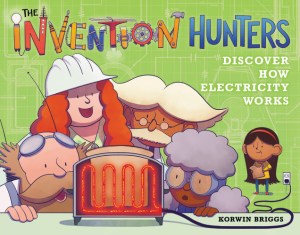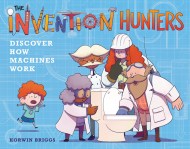Author Essay: Korwin Briggs on writing The Invention Hunters

I was five years old when I discovered electricity. My grandpa, a pipe-smoking former-RAF engineer who didn’t usually suffer fools, had suffered me for a half-hour before handing me a battery, a lightbulb, and two wires, and leaving to talk with the grown-ups. It didn’t take long to work out the puzzle — there are only so many ways to arrange four objects — but I remember how excited I was when I got it right, and had my bright idea punctuated by an actual lit lightbulb.
I remember the next idea I had, too: “Batteries have two ends. Wall outlets have two holes. I wonder…?” One exploded lightbulb later, and my grandpa was never left alone with me again.
I hadn’t thought about that in years, but now that I’ve got some kids’ books coming out, people have started asking why I wrote them, and I keep coming back to that lightbulb and the curiosity that exploded it. Because if there’s one thing I remember about childhood, it’s the curiosity.
If you’ve spent time with a five year old, you might know what I mean. “Why are toasters hot?” “Why do countries have flags?” “Why don’t banana candies taste like bananas?” (Writing these questions got me interested enough that I looked them up and, editor willing, I’ll stick the answers down below). It’s not curiosity as a means to an end, a step toward some diploma or job, and I don’t think it’s a matter of the world having more novelty for someone who’s seen less of it — although I’m sure that helps. It’s just pure, joyful learning for its own sake, following questions wherever they lead, trying things out just to see what happens, delighting in the unknown.

Now that I’m all grown up, at least part of me can relate to my long-suffering teachers, trying to get twenty little heads to stay focused long enough to learn the day’s lesson. But a bigger part of me still remembers the discomfort of boundless curiosity being crammed down specific paths, learning specific subjects at specific times in a specific order from well-meaning adults who loved their students but, like most grown-ups, had left much of their curiosity behind.
I think, in retrospect, that this is what led to the Invention Hunters, because they’re really just that in reverse: A bunch of bumbling adults with more curiosity than sense who go around poking at things and wondering what they are, with a kid following along to explain, guide, and occasionally stop them from blowing up any lightbulbs (or worse).
It’s also why there’s so much history in these ostensibly science-focused books. It might feel cleaner to order things by subject, but it’s hard to learn how a jackhammer works without wondering why (air pressure), or when (late 1800s), or what people used before that (pickaxes and a lot of elbow grease). Well, that, and it’s fun to draw old fashioned machines. If you include the hole in the ground, The Invention Hunters Discover How Machines Work has six generations of toilets.

I doubt every kid who reads an Invention Hunters book will remember every detail of every machine. I don’t remember much from The Way Things Work or The Magic Schoolbus, aside from the mammoths and Ms. Frizzle’s dresses, and I treasured those books. But what I do remember, the part of those books that still animates me today, is how great it felt to be completely curious, to spend an afternoon in total fascination and finish with more questions than I’d had at the start. And if I’m really lucky, I hope The Invention Hunters might make today’s kids feel the same.
Answers for the imaginary five-year-old from paragraph four:
– The hot part of a toaster gets hot because it’s made of a metal that electricity has trouble getting through. The more trouble electricity has traveling through something, the more of it turns to heat. (This is also why bad shocks can cause burns).
– Most European flags started out as banners for ships and armies to wave around so everyone knew whose side they were on. In the 18th and 19th centuries people started using them in civilian contexts, too, and sometime during the 20th the world sort of agreed that countries are supposed to have flags.
– There’s a story that banana candies taste weird because they’re based on a variety of banana that was popular decades ago but almost went extinct in the 60s. However, a quick web search says that’s not true, and that the real reason for the difference is that the taste of real bananas comes from a whole bunch of chemicals, and most artificial banana flavoring uses just one of them.
The Invention Hunters travel the globe in their flying museum collecting the world’s greatest inventions! Today they’ve landed in a construction zone. These silly scientists think they’ve stumbled on incredible specimens of everything you’d never find at a building site, from roller skates and pogo sticks to swords and race cars. But what they really discover–with a kid as their guide–is how simple machines like pulleys, cranks, and levers are used to engineer tools ranging from jackhammers to dump trucks…and even toilets!
Using simple explanations and diagrams and a heaping helping of humor, the Invention Hunters make the perfect companions for curious kids who are ready to learn about science, physics, engineering, history, and more.
The Invention Hunters travel the globe in their flying museum collecting the world’s greatest inventions! This time, they’ve landed in a kid’s backyard, and these silly scientists think they’ve stumbled on incredible specimens, from umbrellas and lipsticks to coins and rockets. But what they really discover–with a kid as their guide–is how electricity and magnetism powers lamps, batteries, and even toasters!
Using simple explanations and diagrams and a heaping helping of humor, the Invention Hunters make the perfect companions for curious kids who are ready to learn about science, physics, engineering, history, and more.

